Journal Selection for Publishing
Selection of the most suitable journal for publishing involves two essential steps – finding the journal and assessing its quality:
- Journals can be searched from various sources, but the most convenient and reliable ones are bibliographic databases and publishers' websites.
- The quality of a journal can be assessed from a variety of perspectives. However, it has become common practice to evaluate journals based on their value of journal citation indicators.
Journal Search in Databases
For finding reliable high-quality journals (peer-reviewed and referenced), it is advisable to perform a journal search in bibliographic databases.
It is important to note that both the coverage and variety of indexed journals and the classification of disciplines vary between databases, so journal search results will also differ.
It is important to note that both the coverage and variety of indexed journals and the classification of disciplines vary between databases, so journal search results will also differ.
Web of Science (WoS) indexed journals can be searched using the Journal Citation Reports (JCR) tool or at the Master Journal List website:

JCR tool allows to perform a targeted search for journals [1] (by title, ISSN number, or keywords), and/or filter JCR indexed journals by selected discipline and/or other criteria [3]:

Methods and criteria for narrowing JCR journal search:

JCR tool allows to perform a targeted search for journals [1] (by title, ISSN number, or keywords), and/or filter JCR indexed journals by selected discipline and/or other criteria [3]:

Methods and criteria for narrowing JCR journal search:
- Targeted search by name / ISSN / category / keywords
- Search in results
- Additional journal selection criteria/filters
- Selection of indicators to be displayed for the searched journals
All Scopus indexed periodical sources (not only journals, but also book series, conference proceedings and trade publications) can be searched in the Source section of the database.

Scopus sources can be searched by: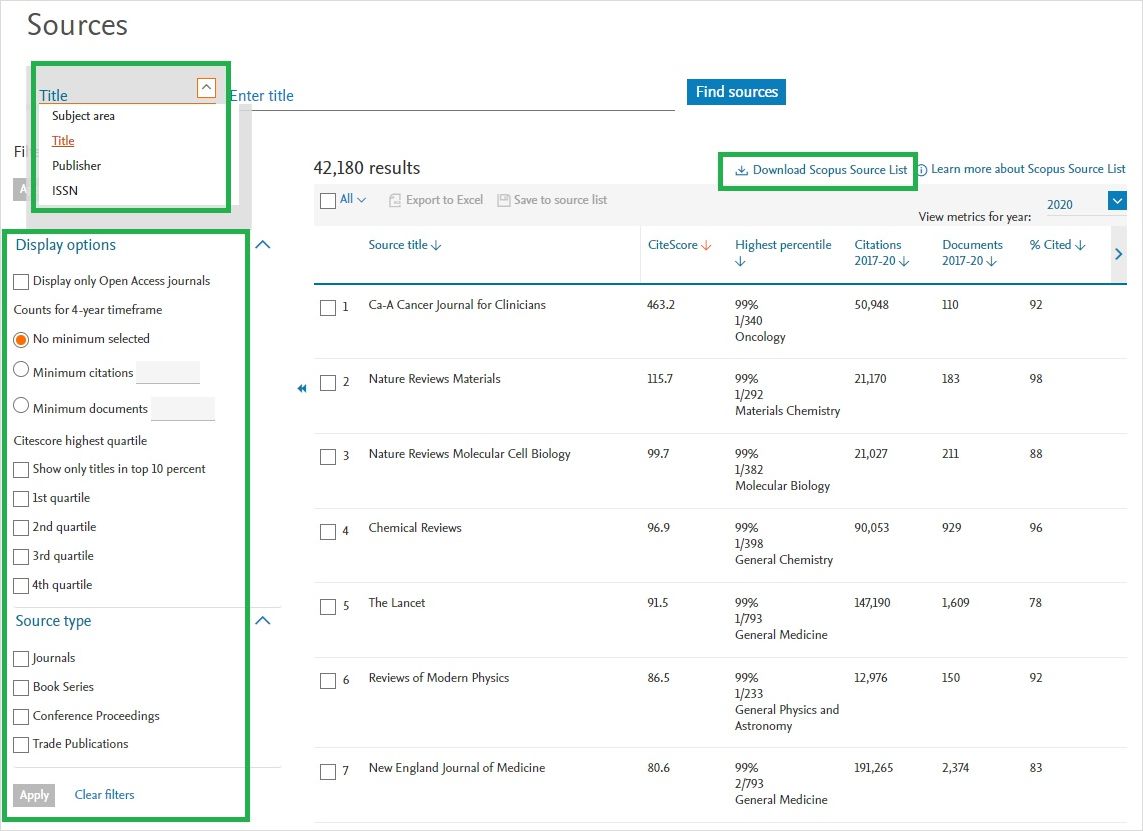
The search can be further narrowed by specifying additional criteria (Display options).
It is also possible to download lists of all Scopus indexed sources in Excel format, which can be filtered by subject areas or by other selected criteria.
Scopus indexed journals can also be searched on the Scimago Journal & Country Rank (SJR) website. Here the journal search can also be refined by selected subject areas or categories, country/region, publication type and year:


Scopus sources can be searched by:
- Title
- Subject area
- Publisher
- ISSN

The search can be further narrowed by specifying additional criteria (Display options).
It is also possible to download lists of all Scopus indexed sources in Excel format, which can be filtered by subject areas or by other selected criteria.
Scopus indexed journals can also be searched on the Scimago Journal & Country Rank (SJR) website. Here the journal search can also be refined by selected subject areas or categories, country/region, publication type and year:

Journal Search on Publisher Websites
Journals can also be searched (by browsing or within specific disciplines) on the individual publishers’ websites:
Emerald Journals
IEEE Explore
Springer Nature Journals
Oxford Journals
Which PLOS journal best fits your research?
PubMed PubReMiner
Sage Journals
Science Journals
SpringerLink
Taylor and Francis Online
Wiley Find a Journal
Having prepared the manuscript, the most convenient way to find the journal most suitable for its publishing is to use the journal search for publishing tools provided by some publishers, which select the most appropriate journals based on the title, summary, and keywords of the manuscript:
Elsevier Journal Finder
IEEE Publication Recommender
Springer Journal Suggester
Wiley Journal Finder
A similar approach is applied in the Match Manuscript tool available on the Master Journal List website, which allows searching for WoS-indexed journals most suitable for publishing the manuscript (in order to use this tool, it is required to have a user account, but the tool can be accessed by login into WoS account used for all other WoS products):
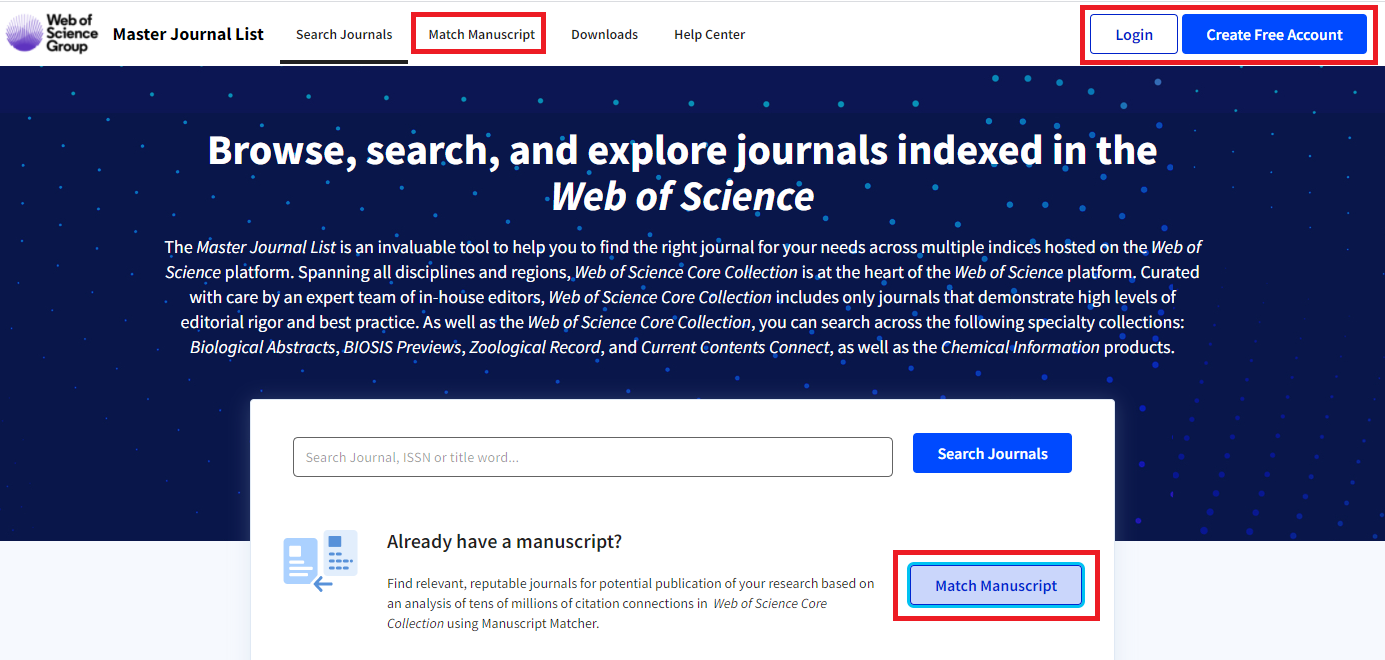
If an article or other type of publication is intended to be published by an open-access model, suitable journals from various publishers can be found in the Open Access source registries, databases, or by filtering open-access sources at publisher websites.
Emerald Journals
IEEE Explore
Springer Nature Journals
Oxford Journals
Which PLOS journal best fits your research?
PubMed PubReMiner
Sage Journals
Science Journals
SpringerLink
Taylor and Francis Online
Wiley Find a Journal
Having prepared the manuscript, the most convenient way to find the journal most suitable for its publishing is to use the journal search for publishing tools provided by some publishers, which select the most appropriate journals based on the title, summary, and keywords of the manuscript:
Elsevier Journal Finder
IEEE Publication Recommender
Springer Journal Suggester
Wiley Journal Finder
A similar approach is applied in the Match Manuscript tool available on the Master Journal List website, which allows searching for WoS-indexed journals most suitable for publishing the manuscript (in order to use this tool, it is required to have a user account, but the tool can be accessed by login into WoS account used for all other WoS products):

If an article or other type of publication is intended to be published by an open-access model, suitable journals from various publishers can be found in the Open Access source registries, databases, or by filtering open-access sources at publisher websites.
Journal Quality Assessment
The quality of journals can be assessed in different aspects, considering:
- Editorial criteria (the most important being the implementation of peer review)
- The composition of the editorial board and the competencies of its members
- Publisher Credibility
- The scope and periodicity of the journal
- Applicable Publishing Models
- Relevance of the covered topics, etc.
However, nowadays the assessment of journal quality is mainly based on citations accrued by the publications published in it. For convenience, citation data of all journal’s publications are expressed as journal citation indicators. Journals are additionally ranked by journal position indicators, determined by the values of the main journal citation indicators.
IMPORTANT! When assessing the qualitative suitability of a journal, it is necessary to take into account the criteria of journal (publications) quality applied in the institutional procedures for accounting and evaluation of scientific production.
IMPORTANT! When assessing the qualitative suitability of a journal, it is necessary to take into account the criteria of journal (publications) quality applied in the institutional procedures for accounting and evaluation of scientific production.
The main bibliographic databases (WoS and Scopus) provide various journal citation indicators, but the main and the most widely used for evaluation purposes are these:
The comparison of the main journal citation indicators provided in WoS and Scopus databases is provided in the table:
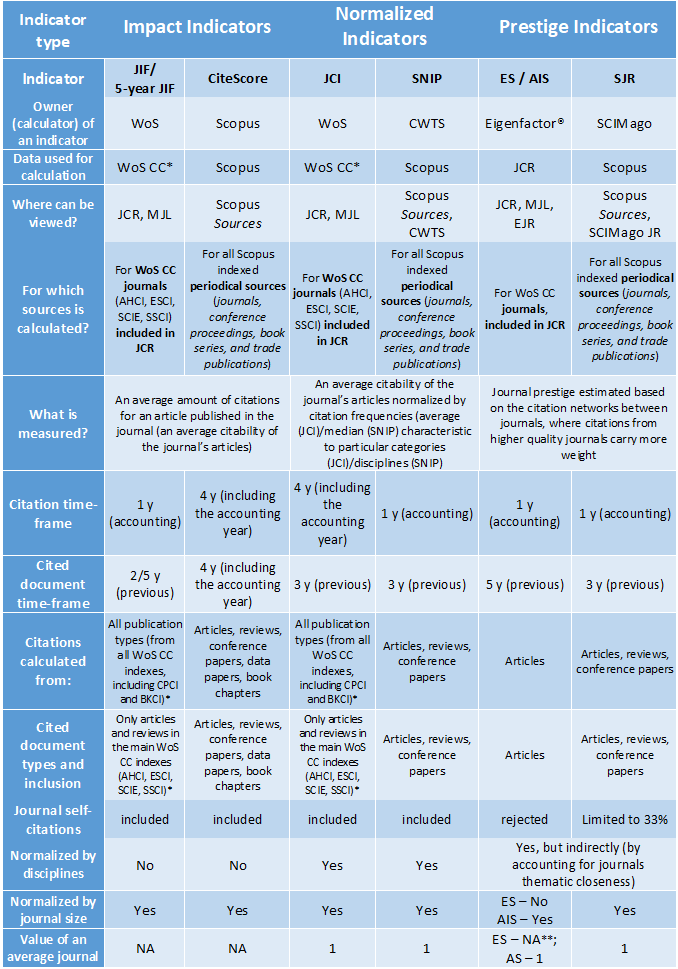
* including data from Early Access publications
** within WoS database the collective ES value of all indexed journals is equal to 100, and, the value of individual journal decreases with the increase of the number of journal‘s publications.
Abbreviations used in the table:
AHCI – Arts & Humanities Citation Index
AIS – Article Influence Score
BKCI – Book Citation Index
CPCI – Conference Proceedings Citation Index
CWTS – Leiden University's Centre for Science & Technology Studies
ESCI – Emerging Source Citation Index
EJR – Eigenfactor Journal Ranking
Eigenfactor®– Eigenfactor® Project (University of Washington)
ES – Eigenfactor Score
JCI – Journal Citation Indicator
JCR – Journal Citation Reports – WoS journal analysis tool
JIF – Journal Impact Factor
MJL – Master Journal List – lists of WoS-indexed journals
NA – not applicable
SCIE – Science Citation Index Expanded
Scopus – Scopus (Elsevier)
Scopus Sources
SCImago – SCIMago Lab
SCImago JR – SCImago Journal Rank (SCIMago Group)
SJR – SCImago Journal Rank
SNIP – Source Normalized Impact per Paper
SSCI – Social Science Citation Index
WoS – Web of Science (Clarivate)
WoS CC – Web of Science Core Collection
More information about the main journal-level quality indicators provided by WoS and Scopus – their calculation principles, differences and limitations – is provided here >>>
IMPORTANT! Since 2023 JIF is also calculated for the journals indexed in ESCI and AHCI WoS editions. However, the quality of publications published in the journals indexed in these WoS indexes might not be assessed equally to the ones published in the main WoS indexes (SCIE and SSCI). Therefore, when selecting journal for publishing it is highly recommended to make sure if the journal meets quality criteria applied in the institutional research evaluation practices (attestations, assignment of academic degree, doctoral degree requirements, assessment of a variable salary part (Lithuanian abbreviation – KDU), etc.)
It is also important to pay attention to the year in which the indicators were calculated. This is especially important when citation and/or position indicators are used to evaluate individual publications, as only the values of the indicators corresponding to the year of publication should be used for this purpose.
- WoS – Journal Impact Factor (JIF);
- Scopus – CiteScore, Source Normalized Impact per Paper (SNIP), and Scimago Journal Rank (SJR).
The comparison of the main journal citation indicators provided in WoS and Scopus databases is provided in the table:

* including data from Early Access publications
** within WoS database the collective ES value of all indexed journals is equal to 100, and, the value of individual journal decreases with the increase of the number of journal‘s publications.
Abbreviations used in the table:
AHCI – Arts & Humanities Citation Index
AIS – Article Influence Score
BKCI – Book Citation Index
CPCI – Conference Proceedings Citation Index
CWTS – Leiden University's Centre for Science & Technology Studies
ESCI – Emerging Source Citation Index
EJR – Eigenfactor Journal Ranking
Eigenfactor®– Eigenfactor® Project (University of Washington)
ES – Eigenfactor Score
JCI – Journal Citation Indicator
JCR – Journal Citation Reports – WoS journal analysis tool
JIF – Journal Impact Factor
MJL – Master Journal List – lists of WoS-indexed journals
NA – not applicable
SCIE – Science Citation Index Expanded
Scopus – Scopus (Elsevier)
Scopus Sources
SCImago – SCIMago Lab
SCImago JR – SCImago Journal Rank (SCIMago Group)
SJR – SCImago Journal Rank
SNIP – Source Normalized Impact per Paper
SSCI – Social Science Citation Index
WoS – Web of Science (Clarivate)
WoS CC – Web of Science Core Collection
More information about the main journal-level quality indicators provided by WoS and Scopus – their calculation principles, differences and limitations – is provided here >>>
IMPORTANT! Since 2023 JIF is also calculated for the journals indexed in ESCI and AHCI WoS editions. However, the quality of publications published in the journals indexed in these WoS indexes might not be assessed equally to the ones published in the main WoS indexes (SCIE and SSCI). Therefore, when selecting journal for publishing it is highly recommended to make sure if the journal meets quality criteria applied in the institutional research evaluation practices (attestations, assignment of academic degree, doctoral degree requirements, assessment of a variable salary part (Lithuanian abbreviation – KDU), etc.)
It is also important to pay attention to the year in which the indicators were calculated. This is especially important when citation and/or position indicators are used to evaluate individual publications, as only the values of the indicators corresponding to the year of publication should be used for this purpose.
In order to search only for journals that meet specific quality criteria, the search of journals in databases can be restricted by specifying the desired quality criteria of the journal. For this purpose, the ranking of the journals in the research categories, expressed in quartiles (Q), is the most widely used quality criterion.
In the main bibliographic databases (WoS and Scopus), journals are divided into category quartiles according to the value of their ranks in the represented research fields/categories, expressed in percentiles. The ranks themselves are determined by the values of the main citation indicators used in that database (in WoS by JIF, in Scopus by CiteScore).
The journals are assigned to quartiles according to the percentile value threshold:
Q1 – [99-75]
Q2 – [74-50]
Q3 – [49-25]
Q4 – [24-0]
By restricting the search for journals by quartiles, the results will include those journals that fall into the selected quartiles in at least one of the research categories they represent. For example, if you search for Q1 journals, the results will return all journals that fall into the Q1 quartile in at least one category, but in other categories to which the journal may be assigned, it may occupy lower quartiles. Therefore, if it is necessary to select the highest-quality journals in a specific field of science, it is recommended to select the research fields/categories of interest in the journal search criteria first.
The most convenient way to search WoS-indexed journals occupying specific category quartiles is to use an additional filter in the Journal Citation Reports (JCR) tool:

In the Scopus database the search for journals belonging to specific quartiles can also be performed:

In Scopus database Source lists and individual journal profiles direct quartile (Q) values are not provided – they must be determined by the journal’s position (rank) in represented research category expressed in percentiles: in order for the journal to be included the in Q1 or Q2, its ranking value in percentiles must be at least 50.
The direct quartile (Q) values occupied by the journal in all represented categories can be reviewed by clicking on the journal’s title in the individual publication’s details page (above publication title).
The quality of Scopus-indexed journals can also be assessed on the Scimago Journal & Country Rank (SJR) website. However, in this case, it is important to note that in the Scimago Journal & Country Rank journals are ranked and assigned to quartiles according to their Scimago Journal Rank (SJR) indicator values, while in Scopus DB journals are rated by their CiteScore values. Therefore, in some cases, the quartiles of the same journal in Scopus DB and in the Scimago Journal & Country Rank websites may not coincide.
In the main bibliographic databases (WoS and Scopus), journals are divided into category quartiles according to the value of their ranks in the represented research fields/categories, expressed in percentiles. The ranks themselves are determined by the values of the main citation indicators used in that database (in WoS by JIF, in Scopus by CiteScore).
The journals are assigned to quartiles according to the percentile value threshold:
Q1 – [99-75]
Q2 – [74-50]
Q3 – [49-25]
Q4 – [24-0]
By restricting the search for journals by quartiles, the results will include those journals that fall into the selected quartiles in at least one of the research categories they represent. For example, if you search for Q1 journals, the results will return all journals that fall into the Q1 quartile in at least one category, but in other categories to which the journal may be assigned, it may occupy lower quartiles. Therefore, if it is necessary to select the highest-quality journals in a specific field of science, it is recommended to select the research fields/categories of interest in the journal search criteria first.
The most convenient way to search WoS-indexed journals occupying specific category quartiles is to use an additional filter in the Journal Citation Reports (JCR) tool:

In the Scopus database the search for journals belonging to specific quartiles can also be performed:

In Scopus database Source lists and individual journal profiles direct quartile (Q) values are not provided – they must be determined by the journal’s position (rank) in represented research category expressed in percentiles: in order for the journal to be included the in Q1 or Q2, its ranking value in percentiles must be at least 50.
- Journal ranks in percentiles at the Scopus Source page source list table are provided only for the category in which the journal occupies the highest position (Highest percentile) compared to the ranks in other journal represented categories.
- Journal's ranking values in all research categories it is assigned to are provided in the journal's profile (listed at the bottom of the profile page).
The direct quartile (Q) values occupied by the journal in all represented categories can be reviewed by clicking on the journal’s title in the individual publication’s details page (above publication title).
The quality of Scopus-indexed journals can also be assessed on the Scimago Journal & Country Rank (SJR) website. However, in this case, it is important to note that in the Scimago Journal & Country Rank journals are ranked and assigned to quartiles according to their Scimago Journal Rank (SJR) indicator values, while in Scopus DB journals are rated by their CiteScore values. Therefore, in some cases, the quartiles of the same journal in Scopus DB and in the Scimago Journal & Country Rank websites may not coincide.
Journal Comparison in Bibliographic Databases
The ability to directly compare several journals becomes especially useful when, after the initial steps of journal search, sorting, and evaluation, there is still more than one potentially suitable journal. The main bibliographic databases (DBs) recognise the importance of this opportunity and provide users with corresponding tools that enable the comparison of their indexed journals. In Scopus, this functionality has been available since the very beginning of DB operation (more detailed information on Scopus indexed sources comparison tool is available here >>>). Meanwhile, the direct comparison of Web of Science (WoS) indexed journals has become possible since the summer of 2022 and can be performed by employing an additional functionality added to the Journal Citation Reports (JCR) journal analysis tool (more information on JCR tools is provided here >>>).
In order to compare WoS-indexed journals, it is needed to first perform a journal search in the JCR tool. After marking at least one of the journals listed in the search results table, an additional toolbar will appear below the table, but the button for journal comparison will activate only after selecting at least two journals from the list (for comparison purposes, it is possible to select up to four journals):
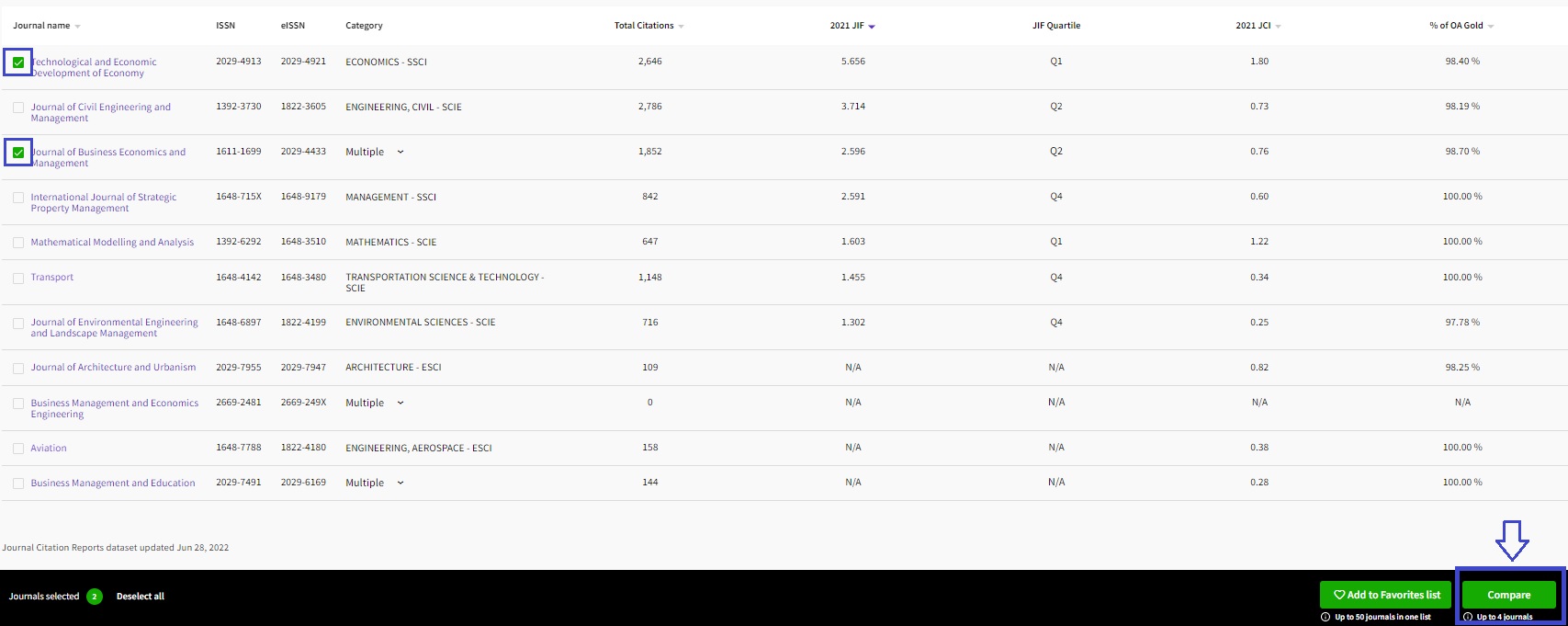
Clicking on the “Compare” button opens a journal comparison window. Here, additional journals can be easily added [2] and/or removed [1] from the comparison. It is also possible to indicate on which JCR year data comparison will be based [3]:

The following information from the compared journals is provided side by side.
- General information (ISSN/eISSN numbers, representing categories, publication country and language, publisher, and indications of the most recent year for which JCR data are available for the journal);
- Information on the main journal citation indicators (JIF, JCI and AIS; more information about these indicators is provided here >>>), including the values of the indicators corresponding to the selected JCR years [3] and their trends for the five-year period (counting backwards from the selected JCR year [3]), as well as the positions of the journals in all categories their represent, also expressed as percentiles and quartiles (Q), separately for the cases of ranking journals by all aforementioned indicators;
- Information on the proportions of journals' content with respect to the applied publishing model and access type, including an indication of which content types are included in the calculations of journal citation indicators as Citable Items.
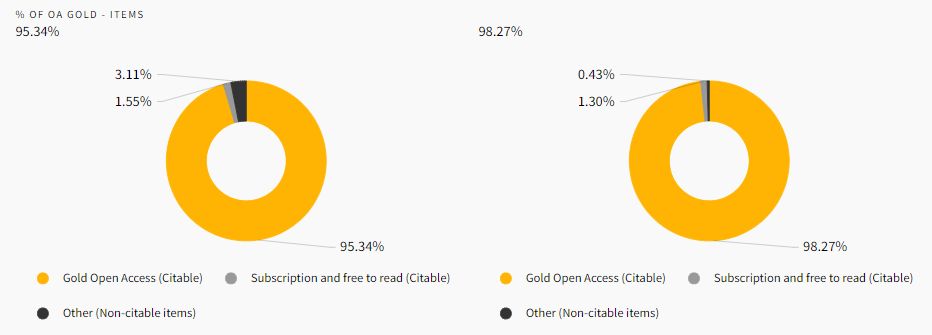
Journal Suitability Assessment
After the initial journal search and/or selection of journals according to their quality and/or other criteria, it is necessary to make sure that the journal is suitable before submitting the manuscript for publication in it.
The main aspects for the evaluation of journal suitability:
- It is necessary to carefully read the Objective and Scope sections of the journal's website and assess their compatibility with the manuscript to be published. It is also advisable to review the articles of the last and/or current issue of the journal, since in the case of some journals (especially large ones) separate journal issues can be focused on a more specific/narrow topic.
- Take into account the editorial provisions applicable to accepted manuscripts (types of publications accepted, restrictions on the manuscript extent (pages/characters), language quality requirements, applied layout and citation styles, etc.).
- Evaluate legal aspects (copyright, licences, publishing ethics, etc.).
- Consider other criteria important to the author (course and speed of the peer review/publication process, available publishing models, related fees, etc.).
In recent decades, along with the increasing number of journals, the variety of publishing models has also expanded. The main difference between these models arises from two main aspects: how the publishing costs are covered/financed, and how does that affect the accessibility of the published content?
Journal type / Publishing model:
Traditional (subscription-based)
- Published content stays behind the paywall, and access to it must be purchased (by subscribing or paying the fee for an individual publication).
- The publication is free of charge.
- In most cases, the author rights of the publication are transferred to the publisher upon signing a Copyright Transfer Agreement.
Gold Open Access
- Published content becomes freely accessible immediately after publishing.
- Publishing charges (Article Processing Charges, APCs) are applied.
- The published content is usually granted with the Creative Commons (CC) licence, ensuring that the author rights are retained by the author (not transferred to the publisher).
Hybrid
- Authors can choose the model, Traditional or Gold Open Access, to be applied when published in such journals.
Journal Credibility Assessment
When searching for a journal on your own or considering publishing in the journal from which you received an invitation, you need to make sure that the journals are credible. With the rapid adoption of the Open Access publishing model, the number of so-called 'predatory' publishers or journals has also increased.
Predatory publishers/journals employ the Open Access publishing model to profit from authors by enticing them with a fast publishing process and low APCs, but without any real benefit to scientific communication: often the article ends up not being published at all, and the manuscript becomes unsuitable for republication in reliable journals. In this case, the authors not only lose the opportunity to publish valuable data and suffer financial losses but also damage their reputation.
Predatory journals often create their profiles/websites by hijacking the information of real and usually well-known journals: journal titles (or at least a very similar one), ISSN, indexing, and/or other information (information about the existing version of the predatory journal can sometimes be found on the website of the real journal). However, a list of other traits may expose the predatory nature of the journal.
Predatory publishers/journals employ the Open Access publishing model to profit from authors by enticing them with a fast publishing process and low APCs, but without any real benefit to scientific communication: often the article ends up not being published at all, and the manuscript becomes unsuitable for republication in reliable journals. In this case, the authors not only lose the opportunity to publish valuable data and suffer financial losses but also damage their reputation.
Predatory journals often create their profiles/websites by hijacking the information of real and usually well-known journals: journal titles (or at least a very similar one), ISSN, indexing, and/or other information (information about the existing version of the predatory journal can sometimes be found on the website of the real journal). However, a list of other traits may expose the predatory nature of the journal.
Main characteristics of a predatory journal:
- Unreasonably fast peer review process;
- Urgent acceptance of the article for publishing;
- Low article publishing fees (APC);
- The physical address of the publisher is not always provided; usually, only electronic contacts (often of academically unrelated e-mail domains, e.g., Yahoo, Gmail, etc.) of the publisher may be found;
- It is not possible to identify the editor-in-chief of the journal;
- The editorial boards often consist of researchers from the same country and without their consent; contact details are not included or are not real;
- The website contains broken links.
How do I identify a predatory journal?
To choose the right journal for publication, it is necessary to evaluate not only the suitability and impact of citations of the journal but also the credibility and international recognition of the publisher and/or the journals.
Predatory journals often indicate that they are indexed in various well-known databases and have a value of a citation indicator, which is actually a pseudoindicator. This often confuses authors who want to publish in high-ranking journals that possess values of the main citation indicators. Examples of pseudoindices: Advanced Science Index, General Impact Factor, Global Impact Factor, Journal Impact Factor, and Scientific Journal Impact Factor. Therefore, it is necessary to check whether the journal is indexed in international databases and/or has national recognition:
- Master Journal List (WoS, Clarivate)
- Journal Citation Reports (WoS, Clarivate)
- Scopus Sources (Elsevier)
- SCImago Journal & Country Rank
- The Association of Lithuanian Serials
Important! With the rapid advancements in information technology, predatory publishers/journals have also improved to the point that even commissions for the inclusion of new sources in major bibliographic databases sometimes do not recognise such journals and they are included from bibliographic databases (over time the unethical and selfish intentions of such journals are usually noticed and the journals are removed from databases).
One of the most trusted and widely recommended tools for assessing the credibility of a journal is THINK. CHECK. SUBMIT.
Another useful tool is A list of predatory journals by US librarian Jeffrey Beall
Additional information for authors
Publishers' advices and trainings on how to write and publish scientific articles:
Presentation video recording >>>
Presentation slides >>>
- Wiley-Blackwell: Author Services
- Elsevier: How to publish in scholarly journals
- Springer: How to submit a publication
- Taylor&Francis: Insights blog
- IEEE: Author Center
Presentation video recording >>>
Presentation slides >>>
-
- Page administrators:
- Jolanta Juršėnė
- Asta Katinaitė-Griežienė
- Olena Dubova
- Orinta Sajetienė
- Ugnė Daraškevičiūtė


